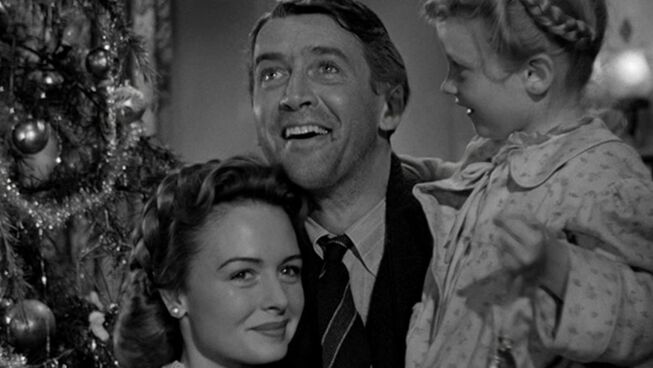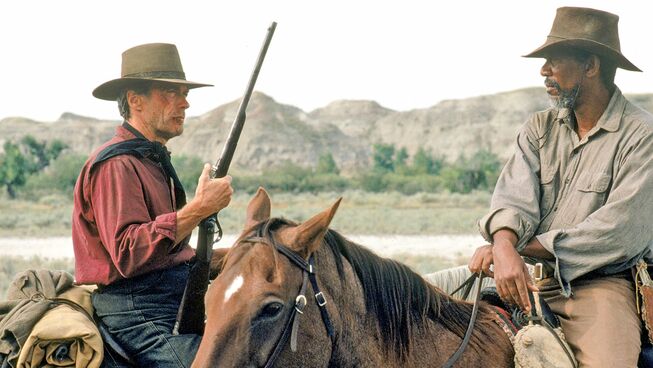
The Christmas classic It’s a Wonderful Life celebrates its diamond anniversary this month. It has been 75 years since director Frank Capra released his dark fairytale about purpose, goodness and sacrifice. The beloved film has become more popular today than when modest crowds first gathered in theatres in December 1946.
Jimmy Stewart plays George Bailey, a decent man with an ambitious dream of leaving the unremarkable community of Bedford Falls, New York. His dream is to travel the world to pursue adventure and self-indulgence. On several occasions George plans his way out of town with a train ticket in hand when the harsh reality of life’s circumstances forces him to choose between sacrifice and personal ambition. When the villainous banker, Henry Potter (Lionel Barrymore), moves to take over the Bailey Building and Loan after its founder Peter Bailey’s untimely death George postpones his plans to save the community from Potter’s threat of foreclosure. The stinging disappointment of a life that has passed him by becomes too much for George to bear and in an act of final desperation, he considers suicide. In that moment of utter hopelessness, an angel named Clarence Odbody (Henry Travers) is dispatched from heaven to save him. Clarence performs a divine intervention of sorts and reveals to George glimpses of a world in which he never existed.
Initial reviews of It’s a Wonderful Life were mixed, and a few prominent critics dismissed the film altogether. Some accused Capra of being overly sentimental and simplistic; one reviewer quipped, “Mr. Capra’s nice people are charming, his small town is a quite beguiling place and his pattern for solving problems is optimistic and facile.” On the other hand, the film’s heavy and sometimes depressing subject matter failed to appeal to a broader audience. The country was still adjusting to life after World War II at its release. Americans were full of fresh hope and optimism and eager to celebrate the first Christmas season in years without the scourge of war. Ironically, the film’s central theme of community overcoming personal crisis should have resonated with post-war society. However, the journey to its uplifting conclusion is dark and takes a while to get there.
Consequently, it was considered a financial flop despite being nominated for five Academy Awards that included Best Actor, Best Picture, and Best Director. The film’s lone Oscar was awarded for Technical Achievement in developing a new method for simulating falling snow. Before this film’s production, the process for creating snow was to crush cornflakes painted white or spray asbestos. While visually appealing, the crunching sound of actors walking on cornflakes was so loud their lines had to be dubbed in later. Asbestos was also suspected as a carcinogen. Intent on shooting live dialogue under falling snow on a four-acre studio backlot in the middle of a summer heatwave. Capra’s team concocted a recipe for faux snow that included carbon dioxide foam used in fire extinguishers, soap, sugar, and water that could be sprayed and blown around at will. The procedure completely revolutionised the use of fake snow in motion pictures.
Despite formal recognition from Hollywood and generally favourable reviews from critics, Capra could not absorb the film’s substantial loss and was forced to sell his independent production company, Liberty Films, to Paramount Pictures. The beloved director behind cherished classics like It Happened One Night and Mr. Smith Goes to Washington never fully recovered from the film's commercial disappointment. Had it not been for a clerical error nearly thirty years after its release Capra’s film may have remained in cinematic obscurity. At the end of its first term of copyright in 1974, Republic Pictures failed to reapply for a second term. The film entered the public domain for another twenty years. Multiple television networks needing to fill expensive holiday time slots could broadcast the film at will and without the obligatory licensing or royalty fees.
For this reason, media mogul, Ted Turner, was able to produce a colourised version of the film that some consider a meddling act of blasphemy. Even Jimmy Stewart, after seeing his film in colour said, “It made me sick to my stomach.” Indeed, Capra was very intentional about shooting the film in black and white. The community of Bedford Falls and its ensemble of key players represent a time capsule of Americana. It is a nostalgic fairytale that needs to be experienced as the director originally intended. Regardless of how the film is experienced, a new generation of home movie viewers was introduced to a very Dickensian cast of characters who reside in the Norman Rockwell-like town of Bedford Falls. Over time the film quickly became a treasured Christmas movie classic that to this day, airs on several television networks throughout the holiday season.
Throughout the film, there is relatable tension between George’s desire to ‘shake the dust from this crummy town’ and experience the world vs. laying aside those aspirations for the benefit of others within his community. George tells Mary, “I don’t want to get married ever to anyone in a moment of frustration. I want to do what I want to do!” Part of him dreads the anchor marriage represents, but part of him is still holding onto hope that Mary will share his dreams. Adding insult to injury, when Potter causes a run on the bank the same day, George and Mary (Donna Reed) are married. The Baileys avoid bankruptcy by lending all their honeymoon money. George remains stuck in what he sees as a life of mediocrity while others pass him by. His brother, Harry, returns to Bedford Falls as a war hero who lands a lucrative job. As kids, George saved Harry from drowning and it was George who later gave Harry his savings and encouraged Harry to go to college in his place. The film’s final act is truly inspiring because its message is timeless. Clarence shows George how intertwined his life is with the lives of others. He says, “Strange, isn’t it? Each man’s life touches so many other lives. When he isn’t around he leaves an awful hole, doesn’t he?”
It is not surprising that the American Film Institute (AFI) ranks It’s a Wonderful Life the most inspirational film of all time. Along with this accolade, it consistently ranks in the top 20 movies of all time. The heartbeat of the screenplay is the search for meaning and purpose through sacrifice for others. Interestingly, this was Jimmy Stewart’s first film since serving in WWII for six years as an army pilot in the Army Air Corps. He flew combat air missions in the European theatre. After the war, he returned to Hollywood a decorated army veteran and a full colonel (in 1959 he was promoted to brigadier general). At first, Stewart did not think he could successfully transition back into filmmaking. He was initially reluctant about taking on the role of George Bailey. Later, when reflecting on his catalogue of 80 films and unprecedented career, Stewart maintained that this family classic was his favourite.
Give this classic a chance this Christmas season and perhaps it will become a favourite for you and your family.
To open more space for reflection and conversation about the real meaning of Christmas and God, go to thirdspace.org.au








